When it comes to modern film audiences, there is very little capable of shocking. Sure, you get the stray straight chick dragged in to watch Last House On The Left with her boyfriend who walks out in disgust, but by and large horror fans are an increasingly tough bunch. Now, when I talk about “snuff” related films in this article it really covers a wide spectrum spanning different genres and styles of filmmaking. Some utilise the notion of snuff in a totally exploitative manner, especially when we look in later parts at the pseudo-snuff movement and films like Flowers Of Flesh And Blood and the August Underground Trilogy, while others approach the subject with far more subtlety and tact. I have tried to watch everything that I could get my hands on relating to the subject of “snuff” although I’m sure there will be things I have missed or forgotten about.
The first part of this series is going to look at some of the snuff-themed films to come out of the 70s and 80s. I will follow up with articles on the colourfully controversial phenomenon of Pseudo-Snuff (which will begin with the Guinea Pig films in case you are wondering why this hasn’t been included in this section) and later more recent films with a snuff theme such as Tesis, Boy Meets Girl, Scrapbook, 8MM and A Serbian Film.
LIFE IS CHEAP AND THEN YOU EAT SHIT
It was during the late 1960s that the snuff film legend first came about when rumours surfaced that nice fella Charles Manson’s family had committed murders in front of the camera (although police found no murder footage). Modern technology and new types of media always manages to bring about new fears and panics over what it can be used for, and I guess it’s a more extreme precursor to today’s “happy slapping” playground culture.
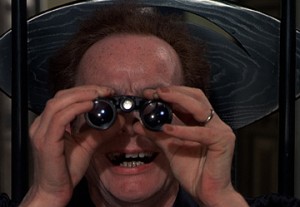 Thinking about older films and especially films set in less modern times, the concept of snuff is hard to incorporate convincingly as the technology either didn’t exist or was not widely available for public consumption. One particularly contentious film that deserves a mention here is Pier Paolo Pasolini’s Salo (or The 120 Days Of Sodom) (1974). Set in 1944 Italy and based on works by the Marquis De Sade, a group of Fascist leaders enslave a group of young girls and boys and subject them to 120 days of sodomy, degradation, torture and sexual abuse (oh and did I mention coprophagia? Be careful if you’re snacking out during this one, you have been warned).
Thinking about older films and especially films set in less modern times, the concept of snuff is hard to incorporate convincingly as the technology either didn’t exist or was not widely available for public consumption. One particularly contentious film that deserves a mention here is Pier Paolo Pasolini’s Salo (or The 120 Days Of Sodom) (1974). Set in 1944 Italy and based on works by the Marquis De Sade, a group of Fascist leaders enslave a group of young girls and boys and subject them to 120 days of sodomy, degradation, torture and sexual abuse (oh and did I mention coprophagia? Be careful if you’re snacking out during this one, you have been warned).
Nearing the end, we arrive at a scene where a number of the prisoners have been taken out into the grounds for punishment where the guards treat the offenders to such tortures as an eye-gouging, tongue-extraction, scalping, penis and nipple burning and branding, strangulation and whippings. This is all viewed by the leaders who watch with gleeful shit-eating grins through binoculars and this all comes across in a particularly voyeuristic fashion, and (hell forbid) should this film ever be remade and given a modern twist one can guess that the leaders would instead be sat around a television whacking one off to the action rather than stood attentively at the upstairs windows. This is a truly epic film that is understandably mired in controversy; utterly cheerless, nihilistic and grim with a capital G. A true anti-feel-good movie, but staying on topic…
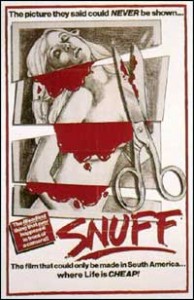 All these years on it just seems incredibly hard to believe that there are genuinely NO snuff movies in existence, and while I am just the right side of the sociopathic divide to (not) engage in such amateur film making, it is nevertheless a concept that has long fascinated me. It is hardly surprising that before long filmmakers would find a way to exploit this legend in order to drum up publicity for their own work. Most notably, South American filmmakers Michael and Roberta Findlay caused a massive uproar about a little movie called Snuff which carried the highly memorable tagline ‘Made In South America – Where Life Is Cheap’. The film was originally released under the title Slaughter in 1972 as what can be fairly described as a painfully dull exploitation movie based loosely on the Manson story. Some four years later, an independent film distributor by the name of Allan Shackleton picked up the film and having previously proved fairly unsuccessful decided the way to get the attention of the public was to tack a five minute “snuff” sequence on the end of this snoozefest.
All these years on it just seems incredibly hard to believe that there are genuinely NO snuff movies in existence, and while I am just the right side of the sociopathic divide to (not) engage in such amateur film making, it is nevertheless a concept that has long fascinated me. It is hardly surprising that before long filmmakers would find a way to exploit this legend in order to drum up publicity for their own work. Most notably, South American filmmakers Michael and Roberta Findlay caused a massive uproar about a little movie called Snuff which carried the highly memorable tagline ‘Made In South America – Where Life Is Cheap’. The film was originally released under the title Slaughter in 1972 as what can be fairly described as a painfully dull exploitation movie based loosely on the Manson story. Some four years later, an independent film distributor by the name of Allan Shackleton picked up the film and having previously proved fairly unsuccessful decided the way to get the attention of the public was to tack a five minute “snuff” sequence on the end of this snoozefest.
The film may have been laughably bad, but Shackleton ran a successful marketing campaign which included the hiring of fake protesters to picket outside the theatre where his film was being shown, soon attracting the attention of Women Against Pornography group who decided to join in the fun and games. Needless to say, the campaign got the film a lot of media coverage and then here in the UK with thanks to everybody’s favourite do-gooder Mary Whitehouse and partner in idiotic crimes against freedom Graham Bright the film earned itself the title of “Video Nasty” and has been immortalised on the infamous DPP list for all future generations of gorehounds must-watch lists (99.9% of whom will all laugh at the absurdity of such a gore-less piece of dross ever being banned and regret wasting 80minutes of their precious time on it; hell, I know I did!)
MUNCHING ON THE RETINA OF THE MIND’S EYEBALL
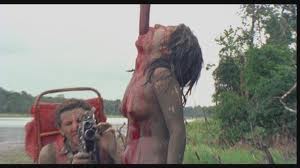 Following on, snuff was one theme that stood virtually a snowball in hells chance against the tireless crusaders of video wholesomeness back in the 1980s and one of the buzzwords that seems to appear every time one of these moral panics arise in the press. One other film that made it very high on the DPP list (and has recently been re-released on Shameless label though still with a number of minutes shaved from it) is Ruggero Deodato’s contribution to the cannibal genre, Cannibal Holocaust (1980). This movement in filmmaking does borrow techniques from the earlier mondo films, in its use of genuine animal cruelty footage which remains a contentious issue both with the censors and audience (as well as animal rights groups). It would be rude not to give some mention of mondo cinema, which has oft been debated as to whether or not such films constitute as “snuff”. The genre basically can be described as a documentary style film which usually focuses on sensational and macabre subjects and utilises real footage of murders, executions, autopsies and other scenes that could be said to exploit the victim in their dying moments. I would argue that the deaths are already happening and does not fall under snuff as it is not people being murdered for the sole purpose of the filming.
Following on, snuff was one theme that stood virtually a snowball in hells chance against the tireless crusaders of video wholesomeness back in the 1980s and one of the buzzwords that seems to appear every time one of these moral panics arise in the press. One other film that made it very high on the DPP list (and has recently been re-released on Shameless label though still with a number of minutes shaved from it) is Ruggero Deodato’s contribution to the cannibal genre, Cannibal Holocaust (1980). This movement in filmmaking does borrow techniques from the earlier mondo films, in its use of genuine animal cruelty footage which remains a contentious issue both with the censors and audience (as well as animal rights groups). It would be rude not to give some mention of mondo cinema, which has oft been debated as to whether or not such films constitute as “snuff”. The genre basically can be described as a documentary style film which usually focuses on sensational and macabre subjects and utilises real footage of murders, executions, autopsies and other scenes that could be said to exploit the victim in their dying moments. I would argue that the deaths are already happening and does not fall under snuff as it is not people being murdered for the sole purpose of the filming.
So the plot of Cannibal Holocaust is basically this; a group of filmmakers head into the jungle to make a documentary…they are never seen again. A search party goes to look for them and instead find a reel of tape which they take back to examine and discover the truth about the crews disappearance (IE they were eaten by cannibals). There are some excellent scenes in this that really stay with you, especially the spiked mudball rape scene (which I recall had me feeling both repulsed and entranced on first viewing) and the newborn baby being drowned at birth, and the soundtrack done by Riz Ortolani is truly haunting. The other fantastic thing about this film is that it raises major questions of who really are the bad guys? Westerners typically look on primitive cultures as uncivilised and their customs as immoral, but what the found footage shows is the Americans taunting and victimising the natives (even going as far as to set fire to their homes) to gain footage, raping their women and generally acting like a real bunch of arseholes. In fact, very typical Western behaviour and it is really hard to say we are more civilised than these tribes when shown in this context. This is a real masterpiece of extreme cinema and has proved highly influential in subsequent decades. Essential viewing.
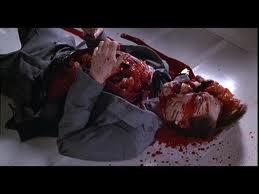 Another highly vital piece of cinema that touches on the snuff theme is Videodrome (1983); that cult classic piece of 80s splatter from David Cronenberg. Max Wren (James Woods) is an executive for a TV station looking to invest in new shows. When he comes across a foreign show by the name of Videodrome, things start to get a little weird for Wren and things spin off into a vortex of hallucinatory confusion. We have an incredibly vampish Debbie Harry starring as quite literally the woman of his dreams who most certainly gets the pulse racing…sexually charged and seductive throughout, she constantly works her wiles on Wren while at the same time seeming to be entranced by the Videodrome show and all it has to offer, as it increasingly infiltrates Wren’s thoughts (the show being a kind of extreme version of “Big Brother” with murder and torture the tasks of the day). A strange and beguiling flick, Videodrome is an allegory of society’s fixation with violence and the way that television and the media can warp the mind and distort our vision of reality. It’s clever without being pretentious, and rightly remains one of the most revered splatter movies of all time.
Another highly vital piece of cinema that touches on the snuff theme is Videodrome (1983); that cult classic piece of 80s splatter from David Cronenberg. Max Wren (James Woods) is an executive for a TV station looking to invest in new shows. When he comes across a foreign show by the name of Videodrome, things start to get a little weird for Wren and things spin off into a vortex of hallucinatory confusion. We have an incredibly vampish Debbie Harry starring as quite literally the woman of his dreams who most certainly gets the pulse racing…sexually charged and seductive throughout, she constantly works her wiles on Wren while at the same time seeming to be entranced by the Videodrome show and all it has to offer, as it increasingly infiltrates Wren’s thoughts (the show being a kind of extreme version of “Big Brother” with murder and torture the tasks of the day). A strange and beguiling flick, Videodrome is an allegory of society’s fixation with violence and the way that television and the media can warp the mind and distort our vision of reality. It’s clever without being pretentious, and rightly remains one of the most revered splatter movies of all time.
IN DA HOUSE!
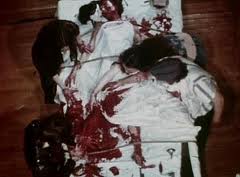 Another sicky from that era comes from little-known director Roger Watkins; Last House On Dead End Street (1977) was his only film of note with his other contributions being firmly within the world of porn. It was mostly unknown who had directed the film until he came out before his death in 2007, perhaps to give that air of snuff-like mystery in a similar way to the director’s concealment behind incredibly sinister masks in the film itself. After finishing a jail sentence for a minor drug offence, Terry Hawkins (played by Watkins) pours all of his anger and efforts into filming a series of snuff films where victims are killed in a range of brutal methods including a power drill and decapitation.
Another sicky from that era comes from little-known director Roger Watkins; Last House On Dead End Street (1977) was his only film of note with his other contributions being firmly within the world of porn. It was mostly unknown who had directed the film until he came out before his death in 2007, perhaps to give that air of snuff-like mystery in a similar way to the director’s concealment behind incredibly sinister masks in the film itself. After finishing a jail sentence for a minor drug offence, Terry Hawkins (played by Watkins) pours all of his anger and efforts into filming a series of snuff films where victims are killed in a range of brutal methods including a power drill and decapitation.
This film is quite clever in the way that it takes the viewer into the tormented mind of our main-man Hawkins, who at times comes across as a bitter and twisted monster for whom it is hard to find any sympathy for. The heart-beating sound-FX compliment this well as does the score in general. The tone of the film is unsettlingly realistic aided by its graininess and seems rather brutal for its time. It’s hard to follow on first viewing but once you’ve worked out what’s actually going on it becomes much more enjoyable. I guess Watkins’ experience in the pornographic industry helped to some extent with the inspiration for this film, which takes a rather grim look at the ways it will exploit the public thirst for more lurid and sensational material. The final scene is definitely not for the faint hearted and it does what Shackleton tried to do with Snuff, but with far more finesse. Its lurid depiction of the gory killing is completely over the top, the special effects are outstanding for it’s time and the sheer splashiness will have most hardened gorehounds salivating.
Rather embarrassingly for the DPP, this little number was missed off the list in error with Tobe Hooper’s harmless slasher Funhouse (also the alternative title for this movie) being included in its place. Whoopsie! The film is not currently available on aUKdistribution label; it was released in 2006 via Tartan Grindhouse however is now out of print and is currently going for around £30 – £40.
SLEAZY DOES IT
 Directed by Joe D’Amato, Emanuelle In America (1977) is one of those glorious examples of European sleaze that is definitely aimed at stimulating the lower appendage rather than any brain cells. That’s not to say that this doesn’t have quite a compelling narrative and it’s good fun if you are willing to accept it for what it is. We have the sultry seductress of all things insalubrious, Laura Gemser, starring as a reporter, in this case investigating a corrupt government official with an insatiable thirst for power and sex who uses his wealth to wield power over vulnerable and sexy young women. Somewhere along her travels Emanuelle stumbles upon an even bigger story involving an underground snuff ring and almost ends up starring in a movie herself…
Directed by Joe D’Amato, Emanuelle In America (1977) is one of those glorious examples of European sleaze that is definitely aimed at stimulating the lower appendage rather than any brain cells. That’s not to say that this doesn’t have quite a compelling narrative and it’s good fun if you are willing to accept it for what it is. We have the sultry seductress of all things insalubrious, Laura Gemser, starring as a reporter, in this case investigating a corrupt government official with an insatiable thirst for power and sex who uses his wealth to wield power over vulnerable and sexy young women. Somewhere along her travels Emanuelle stumbles upon an even bigger story involving an underground snuff ring and almost ends up starring in a movie herself…
Now let’s not kid ourselves here, D’Amato wasn’t attempting anything highbrow here and to say it is some sort of sociological commentary on blah blah blah would be a tad ridiculous. Hardcore porn inserts may seem superfluous and uncalled for (depending on your motives for watching, of course), and the infamous equine hand job scene would make it impossible for this to slip through the BBFC net in one piece. As for the snuff scenes, they are certainly full-on and satisfactory but also rather brief given the non-gory hour and twenty minute build up. Here we see such gornographic delights as a woman having hot tar poured down a funnel into her throat, nipples chopped off, branded and hooked up by the vagina…all in graphic detail of course. This is more an example of how the snuff theme was incorporated into a pornographic context and the way the snuff is actually shown to be viewed by people in the film for the perceived purpose of sexual arousal gives a real sordid feel to things.
IS THIS FOR REAL?
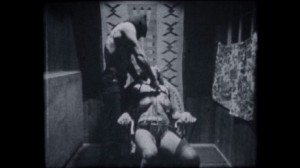 And on to another, perhaps even more obscure, release. With Tom Savini and Joe Pilato both in starring roles, Effects (1980) is a film that promises more than it can deliver. This is basically one of those scenarios where all the action happens around the cast and crew on a film set, and there is a lot of ambiguity about whether what is happening is real or acted out for the camera. Just as you think someone is about to be killed for real, the director yells CUT! The crux of the film is really a scene where the director and a couple of crew members are sat around getting high and watch a movie the director first claims was sent to him in the mail. After watching a woman getting sliced up by a man in a mask, which they all think is so realistic it MUST be a genuine snuff movie, he changes his tune and says it was in fact a short film he made at college and the actress was not harmed and raises a debate on how real you can make something look using only effects.
And on to another, perhaps even more obscure, release. With Tom Savini and Joe Pilato both in starring roles, Effects (1980) is a film that promises more than it can deliver. This is basically one of those scenarios where all the action happens around the cast and crew on a film set, and there is a lot of ambiguity about whether what is happening is real or acted out for the camera. Just as you think someone is about to be killed for real, the director yells CUT! The crux of the film is really a scene where the director and a couple of crew members are sat around getting high and watch a movie the director first claims was sent to him in the mail. After watching a woman getting sliced up by a man in a mask, which they all think is so realistic it MUST be a genuine snuff movie, he changes his tune and says it was in fact a short film he made at college and the actress was not harmed and raises a debate on how real you can make something look using only effects.
There is a strong message behind all of the confusion; how easy is it to figure out what is real and what is staged? Just as the guys in their coked-up states struggle to work out whether the violence in the apparent “snuff” film is real, the viewer is so caught up with trying to fathom whether the attacks are supposed to be happening to the character, or the character within their character, that this is just impossible to follow or make sense of. This is a bad slasher movie that tries too hard to be clever and ultimately winds up losing its audience. On a side note, I must thank the script-writer for educating me with a blow-by-blow account of how to snort cocaine…I can’t imagine the BBFC being very quick to pass this uncut should it ever be submitted for classification in the UK.
WON’T SOMEONE PLEASE THINK OF THE CHILDREN?
 Staying on the subject of low budget b-movies trying to be clever, Video Violence – When Renting Is Not Enough (1987) is one little-known comedy horror that is so low budget it makes the August Underground trilogy look like Pirates Of The Caribbean. Things kick off in a sports shop, where two bumbling employees are so impatient for a game of baseball they could literally murder for it…and decide to hit a home run over a customers head, in a changing room, with CCTV running. Now, this film centres round a new video rentals store that has recently opened in a small town by two outta-towners who seem to think there is something a bit fishy about the place. The people are so unfriendly and they ALL have VCRs. Nowadays that would be very strange indeed, hard-pushed to find folk who even know what a video looks like and VCRs aren’t that easy to get hold of these days; back in 1987 I can see why it would be seen as strange too for quite the opposite reason. Soon enough the townsfolk do turn out to be all murderous loons who have grown so bored with what cinema has to offer they have taken to making their own entertainment. Snuff; it’s fun for the whole family!
Staying on the subject of low budget b-movies trying to be clever, Video Violence – When Renting Is Not Enough (1987) is one little-known comedy horror that is so low budget it makes the August Underground trilogy look like Pirates Of The Caribbean. Things kick off in a sports shop, where two bumbling employees are so impatient for a game of baseball they could literally murder for it…and decide to hit a home run over a customers head, in a changing room, with CCTV running. Now, this film centres round a new video rentals store that has recently opened in a small town by two outta-towners who seem to think there is something a bit fishy about the place. The people are so unfriendly and they ALL have VCRs. Nowadays that would be very strange indeed, hard-pushed to find folk who even know what a video looks like and VCRs aren’t that easy to get hold of these days; back in 1987 I can see why it would be seen as strange too for quite the opposite reason. Soon enough the townsfolk do turn out to be all murderous loons who have grown so bored with what cinema has to offer they have taken to making their own entertainment. Snuff; it’s fun for the whole family!
This is cheap and cheesy; forget wooden acting this is more like cardboard it is that flimsy. But if you can get past all the plot holes and one-dimensional dialogue then this is actually a lot of fun. It’s a case of it being “so bad it’s good!” There are some nice gory set pieces, such as a woman being decapitated and her head being cooked in a soup pan, and some grainy torture scenes.
I said it was trying to be clever, but it’s not quite accurate; it’s more a case that it pokes fun at both itself and the horror genre. It is a bit of a social commentary on the thirst for video violence you know, how ‘all people want these days is horror movies and slasher films, occasionally a xxx from the back’. The very American way of thinking violence is totally acceptable and permeates mainstream culture yet sex and nudity are seen as repulsive, is made very clear in one scene when a mother asks if a film is rated R for nudity. The cashier replies ‘I doubt it, all the violence’. She says ‘Oh then I’ll take it, the kids can watch it’. The film is actually quite eerie in a Stepford Wives or Wicker Man village hiding a dark secret way and it does make you want to keep watching to find out who is behind it all. Worth a watch if you can track it down.
That just about concludes part one of this article and I shall follow up with a piece on Pseudo-Snuff film with some real gore-encrusted gems from the underground for you sick puppies to sniff out.
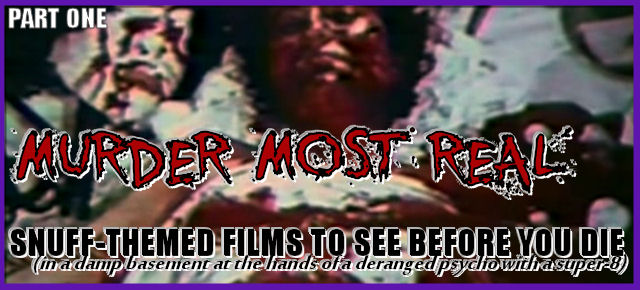

25/05/2015 at 1:29 am
You people who get off on this shit seriously need to get your head examined! WTF IS WRONG WITH YOU? What happened to people like you that you’d enjoy watching people get murdered? These are someones children, uncles, aunts, fathers, mothers, sisters and brothers and you sickos enjoy this? I hope the C.I.A, F.B.I., CSIS, Scotland Yard and others are watching you, I really do because as long as people like you present garbage like this as entertainment, they’ll always be a market! Fucken sickos!
25/05/2015 at 8:10 am
You are quite right Ryan and we have learned the error of our ways.
In fact this particular writer managed to infiltrate just one such organisation who is responsible for making these snuff films and killing our relatives as you so correctly describe. We received back a grainy transmission from them of her last excruciating moments and naturally passed them over to the authorities (who were already in touch with us along with the head-examiners who we are thankfully already well known by) straight away. So far they have drawn a blank but we will forever be tortured by her last gasped words “long live the new flesh!” Unfortunately this means part 2 of this feature cannot be written but perhaps that is for the best.